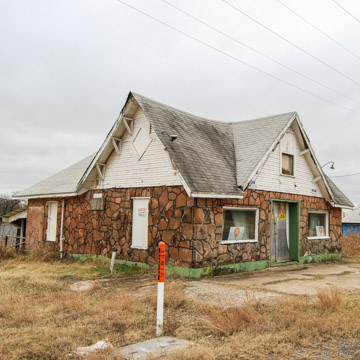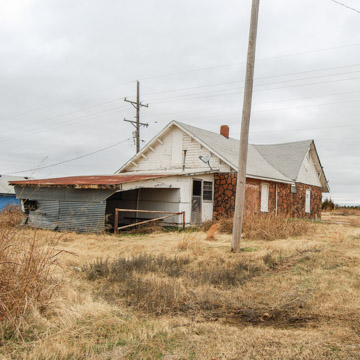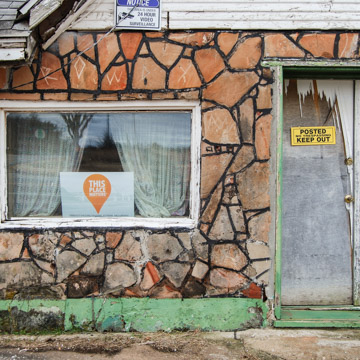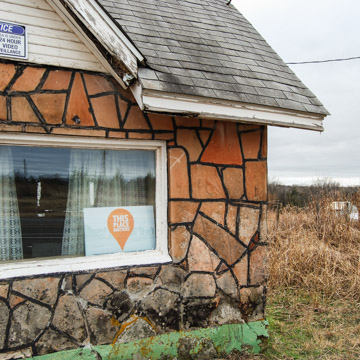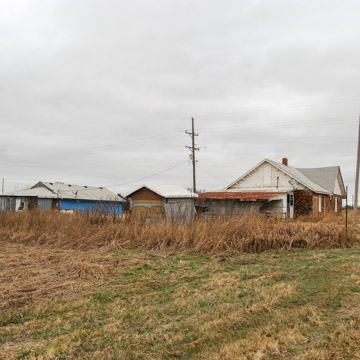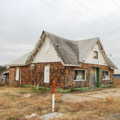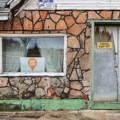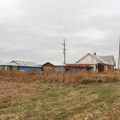In 1915, Allen Threatt built a filling station on what was then State Highway 7, about 20 miles east of Oklahoma City, to serve African American travelers who might otherwise be barred from roadside businesses. The single-story structure blended a residential design with modern commercial features such as the glass-topped fuel pumps, central recessed steel doors flanked by large picture windows, and three flood lights that illuminated the station entrance.
Along with other African American families, the Threatts settled in Luther, Oklahoma, after the area opened for homesteading in 1889. Threatt erected the gas station on the northern edge of the family property, where they also farmed and quarried local stone. The building is constructed in a vernacular Craftsman style, with local sandstone mortared with beaded joints on a concrete foundation. The stone walls form a square plan that is roofed by four cross gables inset with weatherboards with small diamond-shaped windows set into the gable front. Overhanging eaves, exposed beams, and knee braces also contribute to the Craftsman details. On the broad, front-facing gable, is a single one-over-one window set above the door. A brick chimney on the rear gable, no longer visible due to additions, is also thought to be original to the building.
When Route 66 came through Oklahoma City in 1929, absorbing State Highway 7, Threatt’s Filling Station was well placed to attract tourist traffic coming west from St. Louis or east from Amarillo along the Mother Road, as Route 66 was colloquially known. Although it did not appear in guides like the Green Book, which were published to assist black travelers, it was likely well patronized due to its position on Route 66 between cities with large African American populations. The filling station originally had two fuel pumps and a sign, both no longer extant, and provided food and a restroom as well as fuel—valuable commodities for African American travelers who often drove for hours between friendly accommodations. Over several decades of operation, the Threatt family also began serving barbecue and offering camping on the property. Like many African American roadside businesses during the period before the Civil Rights Act of 1964, Threatt’s Filling Station expanded to provide other services that African American travelers needed, and also employed many family members in different capacities. It operated until the 1950s.
In 1940 the original glass-topped pumps were replaced with enamel-clad ones, and around 1961, there was a residential addition built at the rear of the main structure. A carport and a single-story shed were also added to the rear at a later date. Listed on the National Register of Historic Places since 1995, Threatt’s Filling Station was recently awarded a cost-share grant through the National Park Service Route 66 Corridor Preservation Program to assist with the future preparation of a Historic Structures Report.
References
Meacham, Maryjo, Brenda Peck, Lisa Bradley, and Susan Roth, “Threatt Filling Station,” Oklahoma County, Oklahoma. National Register of Historic Places Registration Form, 1994. National Park Service, U.S. Department of the Interior, Washington, D.C.
Meacham, Maryjo, Brenda Peck, Lisa Bradley, and Susan Roth, “Route 66 and Associated Historic Resources in Oklahoma.” National Register of Historic Places Registration Multiple Property Listing, 1995. National Park Service, U.S. Department of the Interior, Washington, D.C.
Shelton, Dawn. “On the Way to a Comeback, Threatt Filling Station.” The Luther Register (Luther, OK), November 28, 2018.
“Threatt Filling Station, Luther, Oklahoma.” National Park Service. Accessed May 14, 2020. https://www.nps.gov/.














